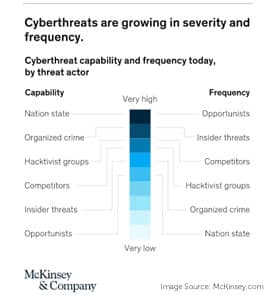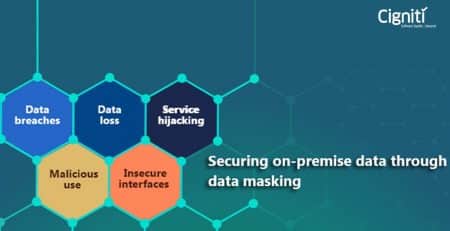How to build a sustainable cyber security plan
The 16th National Cyber Security Awareness Month (NCSAM) is approaching its conclusion. Focusing on the idea of ‘Own IT. Secure IT. Protect IT’, NCSAM 2019 emphasized the need for prevention of cyber attacks amidst the rising digital footprint. The Director of Cybersecurity and Infrastructure Security Agency (CISA), Christopher Krebs points out, “The consequences of not getting security right go well beyond just having to get a replacement credit card. The decisions we make online can have local, regional and even global implications.”
Today, when cyber attacks are considered the biggest possible threat that humanity will have to deal with, an effective, timeless, and robust strategy becomes indispensable. Cyber threats also evolve with the advancing technologies, always lurking behind the shadows of feeble security walls of an organization’s IT infrastructure, eyeing for the minutest gaps to seep through.
In the words of Stephane Nappo – “It takes 20 years to build a reputation and few minutes of cyber-incident to ruin it.”
The key to unbreachable security is to build a strong cyber security plan that is able to extend protection against attacks to the organizations as well as the individuals, a plan that enables timely detection of a risk or even a breach, and bestows the power to an organization to tackle it effectively – a sustainable plan that is measurable and offers actionable insights.
In order to stay secure, every organization would require a customized and personalized cybersecurity strategy. One size would not fit everyone. The strategy will have to be tailored as per the risk landscape, security structure, and threat dealing capabilities of an organization.

There is no dearth of cyber attack incidents to learn from in the history. From small and medium-sized businesses to multi-national enterprises as well as governments, everyone has been a prey to cyber attackers in one way or another. As we expand our digital capabilities, we must also work parallelly to enhance the security levels around our cyber realm. Let us understand how one can develop a sustainable cyber security plan that facilitates survival and success in this era of digitalization.
Get a clear picture
First things first, understand where you stand presently in terms of your risk tolerance and attack prevention capabilities. Map the unique attributes of your organization to a risk assessment framework for identifying the processes that are most and least susceptible to cyber attacks. Learn the viability and scope of the existing cybersecurity measures that are deployed across the organization to analyze them against the current threat actors.
Doing so will help eliminate the need to make assumptions, allowing you to take fact-based strategic decisions. Once the weakest and strongest links in the entire organizational framework are identified, it gets convenient to build a transparent and efficient cybersecurity plan.
Align your people
People alignment involves a bi-directional approach. On one hand, you need to involve the top management by making them understand the criticality of investing in cybersecurity measures. Simultaneously, you would also require to convince and encourage the staff members to incorporate best security practices for preventing any potential breach.
Two of the most expensive data breaches in history during the past year were caused by inside threat actors, including careless workers, inside agents, disgruntled employees, malicious insiders, and third-party users. Lack of awareness about an organization’s cybersecurity policies is also one of the biggest reasons for such breaches. Therefore, it is essential that you ensure everyone is on the same page of the cybersecurity handbook.
Set the metrics
After performing a risk analysis of your organization, you will be able to understand which business processes hold the most value, which areas require special focus of the information security teams, and which are most prone to a malicious attack. This will allow you to get a fair perspective on your organization’s risk appetite, enabling you to determine how and where to distribute your cybersecurity budget and resources.
Without measurable metrics, every strategy is just a shot in the dark with no way of knowing whether it hit the target or if at all it is going in the right direction. Evaluation of the cybersecurity strategy would need a comparative analysis between the Key Risk Indicators (KRIs) and Key Performance Indicators (KPIs). Each risk should be assessed against the activities undertaken to mitigate it and whether those activities are having any impact on the risk levels or not.
By doing this, you will be able to eliminate the wastage by removing the ineffective processes, thus, optimizing your strategy as per the risk appetite of your organization.
Avoid, Accept, Mitigate, and Transfer
Despite having a powerful strategy in place, you can never rest assured with 100% breach-proof walls. That is why, it is crucial that you also prepare a war strategy, i.e., the course of action that you should take to treat cybersecurity risks.
- Avoid: As much and as far as possible, avoid cyber risks by not doing certain activities that might compromise the integrity of your organization’s cybersecurity framework.
- Accept: For minor risks that have already been identified, it is advisable to deal with them when they occur and not waste valuable resources for something insignificant.
- Mitigate: Try to minimize the impact of critical risks by mitigating the chance of their occurrence.
- Transfer: Distribute ownership among different organizational segments for different risks, so that everyone knows their responsibility in the event of a breach.
Test, Assure, Secure, and Protect
With the changing technology landscape, the cyberrisks landscape is also changing. From the earlier maturity-based model, organizations should now move to a risk-based approach.
Application security testing should be performed rigorously and continuously, especially in the high-risk areas. Having an application security testing framework strengthen your cybersecurity plan and having a continuous security testing framework makes your cybersecurity plan sustainable.
Cigniti possesses rich expertise in Security Testing of enterprise applications, catering to diversified business needs. Cigniti has immense experience in serving clients across different industry verticals and organization sizes. Our Web application penetration testing uncovers vulnerabilities in applications and ensures the application risks are minimized. In addition, our code analyzers ensure your software code is benchmarked for increased quality assurance. Connect with us today.





Leave a Reply